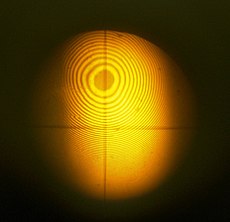Newton's rings: Difference between revisions
No edit summary |
No edit summary |
||
| Line 15: | Line 15: | ||
==Theory== |
==Theory== |
||
There is light incident on the flat plane of the convex lens which is situated on the optically flat glass surface below, the light passes through the glass lens until it comes to the glass-air boundary, here the light goes from a higher refractive index (n) value to a lower n value. The light passes through this boundary and suffers no phase change. Also at this boundary, some light is transmitted into the air and some light is reflected. The light that is transmitted to the air travels a distance t before it is reflected at the flat surface below, the air-glass boundary causes a a half-cycle phase shift because the air has a lower refractive index than the glass. The two reflected rays now travel in the same direction to be detected. The convex lens touches the flat surface below and from this point, as you get further away, the distance t increases because the lens is curving away from the surface. |
There is light incident on the flat plane of the convex lens which is situated on the optically flat glass surface below, the light passes through the glass lens until it comes to the glass-air boundary, here the light goes from a higher refractive index (n) value to a lower n value. The light passes through this boundary and suffers no phase change. Also at this boundary, some light is transmitted into the air and some light is reflected. The light that is transmitted to the air travels a distance t before it is reflected at the flat surface below, the air-glass boundary causes a a half-cycle phase shift because the air has a lower refractive index than the glass. The two reflected rays now travel in the same direction to be detected. The convex lens touches the flat surface below and from this point, as you get further away, the distance t increases because the lens is curving away from the surface. |
||
[[File:newtons rings.svgz]] |
|||
For the triangle:<br /> |
For the triangle:<br /> |
||
Revision as of 06:54, 20 September 2010


The phenomenon of Newton's rings named after Isaac Newton, is an interference pattern caused by the reflection of light between two surfaces - a spherical surface and an adjacent flat surface. When viewed with monochromatic light it appears as a series of concentric, alternating light and dark rings centered at the point of contact between the two surfaces. When viewed with white light, it forms a concentric ring pattern of rainbow colors because the different wavelengths of light interfere at different thicknesses of the air layer between the surfaces. The light rings are caused by constructive interference between the light rays reflected from both surfaces, while the dark rings are caused by destructive interference. Also, the outer rings are spaced more closely than the inner ones. Moving outwards from one dark ring to the next, for example, increases the path difference by the same amount λ, corresponding to the same increase of thickness of the air layer λ/2. Since the slope of the lens surface increases outwards, separation of the rings gets smaller for the outer rings.
The radius of the Nth Newton's bright ring is given by
where N is the bright ring number, R is the radius of curvature of the lens the light is passing through, and λ is the wavelength of the light passing through the glass.
The phenomenon was first described by Robert Hooke in his 1664 book Micrographia although its name derives from the physicist Isaac Newton, who was the first to analyze it.
- NOTE: The above formula is applicable only for Newton's rings obtained by reflected light.
Theory
There is light incident on the flat plane of the convex lens which is situated on the optically flat glass surface below, the light passes through the glass lens until it comes to the glass-air boundary, here the light goes from a higher refractive index (n) value to a lower n value. The light passes through this boundary and suffers no phase change. Also at this boundary, some light is transmitted into the air and some light is reflected. The light that is transmitted to the air travels a distance t before it is reflected at the flat surface below, the air-glass boundary causes a a half-cycle phase shift because the air has a lower refractive index than the glass. The two reflected rays now travel in the same direction to be detected. The convex lens touches the flat surface below and from this point, as you get further away, the distance t increases because the lens is curving away from the surface.
For the triangle:
so therefore:

![{\displaystyle r_{N}=\left[\left(N-{1 \over 2}\right)\lambda R\right]^{1/2},}](https://wikimedia.org/api/rest_v1/media/math/render/svg/32beeb2fa90ea9782b490d6be13ac88032dc3a88)





